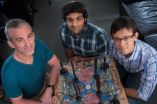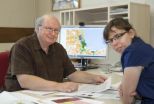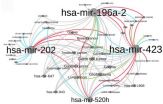(Press-News.org) Rice University wireless researchers have found a way to make the most of the unused UHF TV spectrum by serving up fat streams of data over wireless hotspots that could stretch for miles.
In a presentation today at the Association for Computing Machinery's MobiCom 2014 conference in Maui, Hawaii, researchers from Rice's Wireless Network Group will unveil a multiuser, multiantenna transmission scheme for UHF, a portion of the radio spectrum that is traditionally reserved for television broadcasts.
"The holy grail of wireless communications is to go both fast and far," said lead researcher Edward Knightly, professor and chair of Rice's Department of Electrical and Computer Engineering. "Usually, you can have one or the other but not both. Wireless local area networks today can serve data very fast, but one brick wall and they're done. UHF can travel far, but it hasn't had the high capacity of WiFi.
"This provides the best of both worlds," he said of the new technology.
Rice's technology combines several proven technologies that are already widely used in wireless data transmission. One of these is "multiple-input, multiple-output" (MIMO), a scheme that employs multiple antennae to boost data rates without the need for additional channels or transmitter power. In effect, MIMO allows for a larger wireless "pipeline," and the technology is standard in the latest generation of wireless routers and networking equipment.
Parts of the UHF spectrum were opened after the recent switch to digital television, which has a smaller broadcast footprint than analog TV. UHF is often referred to as the "beach front" portion of the wireless spectrum because the signals travel for miles, and one popular idea for the liberated portion of the spectrum is for "open" wireless access points like those used for today's WiFi hotspots. Using UHF for broadband Internet is particularly appealing for rural areas where wired brandband is unavailable.
"When comparing UHF and WiFi, there's usually a tradeoff of capacity for range or vice versa," said Rice graduate student Narendra Anand, the lead author of the new study. "Imagine that the WiFi access point in your home or office sends data down a 100-lane highway, but it's only one mile long. For UHF, the highway is 100 miles long but only three or four lanes wide. And you cannot add any lanes.
"To be able to leverage the best characteristics of the UHF band, we need to be able to efficiently use the lanes that we have," Anand said. "One way to do that is with multiuser MIMO, a multiantenna transmission technique that serves multiple users over the same channel simultaneously."
Knightly, Anand and Rice graduate student Ryan Guerra designed the first open-source UHF multiuser MIMO test system. Based on Rice's "wireless open-access research platform," or WARP, the system allowed the team to perform a side-by-side comparison of multiuser MIMO for UHF and for both 2.4 gigahertz and 5.8 gigahertz WiFi.
"Based on over-the-air experiments in a range of indoor and outdoor operating environments, we found that UHF-band multiuser MIMO compared favorably and produced high spectral efficiency as well as low-overhead wireless access," Knightly said.
INFORMATION:
Rice wireless experts tap unused TV spectrum
Experts create multiuser, multiantenna scheme to make most of UHF band
2014-09-09
ELSE PRESS RELEASES FROM THIS DATE:
Globalization threatens benefits of an African 'green revolution'
2014-09-09
A prospective "green revolution" in Africa could boost land use and carbon emissions globally, according to a study co-authored by a University of British Columbia researcher.
The term "green revolution" typically describes the use of agricultural innovations – such as the development of new seeds – to increase yields, particularly in developing countries.
Past green revolutions in Asia, Latin America and the Middle East have spared land and carbon dioxide emissions. However, in an increasingly globalized economy, an African green revolution could lead to opposite outcomes, ...
This week from AGU: Global food trade, weather forecasting, aerosol transport
2014-09-09
From AGU's blogs: Global food trade may not meet all future demand, new study indicates
As the world population continues to grow, by about 1 billion people every 12 to 14 years since the 1960s, the global food supply may not meet escalating demand – particularly for agriculturally poor countries in arid to semi-arid regions, such as Africa's Sahel, that already depend on imports for much of their food supply, according to a new study published online in the American Geophysical Union journal, Earth's Future.
From this week's Eos: Next-Generation Forecasting of High-Impact ...
Kessler Foundation multiple sclerosis researchers find role for working memory in cognitive reserve
2014-09-09
West Orange, NJ. September 9, 2014. Kessler Foundation scientists have shown that working memory may be an underlying mechanism of cognitive reserve in multiple sclerosis (MS). This finding informs the relationships between working memory, intellectual enrichment (the proxy measure for cognitive reserve) and long-term memory in this population. "Working memory mediates the relationship between intellectual enrichment and long-term memory in multiple sclerosis: An exploratory analysis of cognitive reserve" (doi: 10.1017/S1355617714000630) was published online ahead of ...
Proactive office ergonomics can increase job satisfaction and employee retention
2014-09-09
As the amount of time employees spend at their desks increases, so does musculoskeletal discomfort and other health issues associated with the office environment. Although office ergonomics training programs have been shown to improve employee well-being and productivity, in many cases training occurs only after complaints are logged. New research to be presented at the HFES 2014 Annual Meeting in Chicago demonstrates that a comprehensive and proactive workplace ergonomics program can help to prevent discomfort and injury.
Alan Hedge, coauthor of "Proactive Office Ergonomics ...
New map tool identifies patterns of racial diversity across the US
2014-09-09
University of Cincinnati geography researchers have developed a large-scale mapping technique to track a variety of demographic data across the United States, including researching populations based on gender, race and economic diversity. Details on the technique behind the new, high resolution, grid-based map of U.S. demographics developed by Anna Dmowska, a postdoctoral fellow for UC's Space Informatics Lab, and Tomasz Stepinski, the Thomas Jefferson Chair Professor of Space Exploration at UC, are published in this month's issue of Applied Geography. The map can also ...
Gambling is just plain fun for those players who are in control
2014-09-09
People who are in control of their gambling habits play for fun and like the idea of possibly winning big. They set limits on how much money and time they can spend, and they are likely to gamble on the internet. But gambling is just one of several leisure activities these players undertake. In contrast, gambling is a form of escapism for problem players and often their only social activity, say Richard Wood of GamRes Ltd. in Canada, and Mark Griffiths of Nottingham Trent University in the UK. The results appear in Springer's Journal of Gambling Studies.
Their study is ...
1 in 5 young men unable to purchase emergency contraception
2014-09-09
September 9, 2014 -- Male shoppers in search of emergency contraception do not always have an easy time making these purchases and may be turned away at their local pharmacies. A "mystery shopper" survey conducted in New York City by researchers at Columbia University's Mailman School of Public Health and Columbia University Medical Center showed that males had a 20 percent likelihood of not being able to purchase emergency contraception. Nearly three-quarters of the pharmacies in the study created barriers for the males to get the contraception. This is the first research ...
Sickle cell patients who experience discrimination miss out on treatment
2014-09-09
Experiencing discrimination because of their race or health condition can influence just how much trust people put into the health profession. In fact, having these experiences was associated with a 53-percent increase in the chances that someone suffering from sickle cell disease will not follow their doctors' orders, says Carlton Haywood Jr. of the Berman Institute of Bioethics and the Johns Hopkins School of Medicine in the US. Haywood led a study appearing in The Journal of General Internal Medicine, published by Springer, into the experiences of how patients who suffer ...
National Renewable Energy Laboratory updates cetane data used for development of energy efficient fuels and engines
2014-09-09
The Energy Department's National Renewable Energy Laboratory (NREL) has released a long-anticipated update to the source-of-record for cetane number data. This information is vital to the development of new, energy-efficient, low-carbon fuels and compatible engines. Researchers, as well as members of the engine, vehicle, and fuel industries, rely on these numbers to target compounds for development of new fuels capable of greater energy efficiency, cleaner emissions, and maximum performance in diesel engines.
A cetane number is a relative ranking of fuels based on the ...
Penn study finds genetic mutations linked with ethnic disparities in cancer
2014-09-09
One of the goals of genome sequencing is to identify genetic mutations associated with increased susceptibility to disease. Yet by and large these discoveries have been made in people of European or Asian ancestry, resulting in an incomplete picture of global genetic variation in disease vulnerability.
In a new study published in the journal BMC Medical Genomics, researchers at the University of Pennsylvania have addressed this omission. Their investigation identified more than 30 previously undescribed mutations in important regulatory molecules called microRNAs. Many ...
LAST 30 PRESS RELEASES:
SIMJ announces global collaborative book project in commemoration of its 75th anniversary
Air pollution exposure and birth weight
Obstructive sleep apnea risk and mental health conditions among older adults
How talking slows eye movements behind the wheel
The Ceramic Society of Japan’s Oxoate Ceramics Research Association launches new international book project
Heart-brain connection: international study reveals the role of the vagus nerve in keeping the heart young
Researchers identify Rb1 as a predictive biomarker for a new therapeutic strategy in some breast cancers
Survey reveals ethical gaps slowing AI adoption in pediatric surgery
Stimulant ADHD medications work differently than thought
AI overestimates how smart people are, according to HSE economists
HSE researchers create genome-wide map of quadruplexes
Scientists boost cell "powerhouses" to burn more calories
Automatic label checking: The missing step in making reliable medical AI
Low daily alcohol intake linked to 50% heightened mouth cancer risk in India
American Meteorological Society announces Rick Spinrad as 2026 President-Elect
Biomass-based carbon capture spotlighted in newly released global climate webinar recording
Illuminating invisible nano pollutants: advanced bioimaging tracks the full journey of emerging nanoscale contaminants in living systems
How does age affect recovery from spinal cord injury?
Novel AI tool offers prognosis for patients with head and neck cancer
Fathers’ microplastic exposure tied to their children’s metabolic problems
Research validates laboratory model for studying high-grade serous ovarian cancer
SIR 2026 delivers transformative breakthroughs in minimally invasive medicine to improve patient care
Stem Cell Reports most downloaded papers of 2025 highlight the breadth and impact of stem cell research
Oxford-led study estimates NHS spends around 3% of its primary and secondary care budget on the health impacts of heat and cold in England
A researcher’s long quest leads to a smart composite breakthrough
Urban wild bees act as “microbial sensors” of city health.
New study finds where you live affects recovery after a hip fracture
Forecasting the impact of fully automated vehicle adoption on US road traffic injuries
Alcohol-related hospitalizations from 2016 to 2022
Semaglutide and hospitalizations in patients with obesity and established cardiovascular disease
[Press-News.org] Rice wireless experts tap unused TV spectrumExperts create multiuser, multiantenna scheme to make most of UHF band





